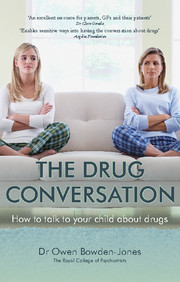Book contents
- Frontmatter
- Contents
- Acknowledgements
- Introduction
- 1 What are psychoactive drugs, who uses them and why?
- 2 Drug use and adolescence
- 3 Having the drug conversation with your child
- 4 Drugs and the brain
- 5 Types of drugs
- 6 Rise of the synthetics
- 7 Detecting drug use and what to do about it
- 8 Treatment and recovery
- 9 Final thoughts
- Appendix
- References
- Index
1 - What are psychoactive drugs, who uses them and why?
Published online by Cambridge University Press: 01 January 2018
- Frontmatter
- Contents
- Acknowledgements
- Introduction
- 1 What are psychoactive drugs, who uses them and why?
- 2 Drug use and adolescence
- 3 Having the drug conversation with your child
- 4 Drugs and the brain
- 5 Types of drugs
- 6 Rise of the synthetics
- 7 Detecting drug use and what to do about it
- 8 Treatment and recovery
- 9 Final thoughts
- Appendix
- References
- Index
Summary
What are psychoactive drugs?
A psychoactive drug is a chemical substance that alters the functioning of the brain, causing changes in the way we think, feel and behave. All drugs can be divided into those that have psychoactive effects and those that don't. Most drugs, for example medications like antibiotics, are not psychoactive. Antibiotics treat infections but they don't change our emotions.
Psychoactive drugs can be stimulating, sedating, cause hallucinations or produce an out-of-body state called dissociation. Some psychoactive drugs can cause more than one of these effects.
How much of a problem are psychoactive drugs?
Before we talk more about psychoactive drugs and the problems they can cause, let's look at how commonly they are used. The United Nations Office on Drugs and Crime (2014) estimates that around one person in twenty of the world's population between 15 and 64 years of age has used an illicit psychoactive drug in the past year. That's around 250 million people. Of these people, about one in ten experience problems with their drug use. The same report estimates that, globally, 183 000 people a year die from drug-related causes: about 40 people per million.
The UK government conducts an annual survey estimating drug misuse in England and Wales (Home Office, 2014). It shows that around one in three adults have taken an illicit drug at some point during their lives, and about one in twelve have used drugs in the past year. As with all surveys, some people will not tell the truth, inflating or reducing the estimates, but a yearly survey does give an indication of changes in patterns of drug use over time. The survey results suggest that the past decade has seen a gradual reduction in the number of people using drugs, and this seems to be true for all age groups.
While heroin use seems to be declining in the general population and in young people in particular, other drugs seem to be gaining popularity: cannabis and the so-called legal highs. Most newer drugs are not accurately recorded in surveys, so their use is likely to be underestimated. Chapter 6 discusses them in more detail.
- Type
- Chapter
- Information
- The Drug Conversation , pp. 5 - 18Publisher: Royal College of PsychiatristsPrint publication year: 2016



